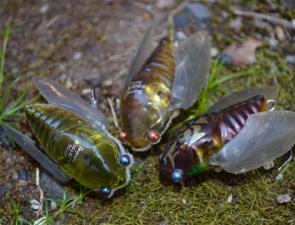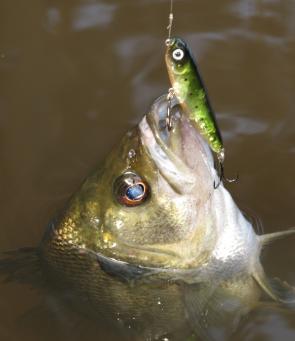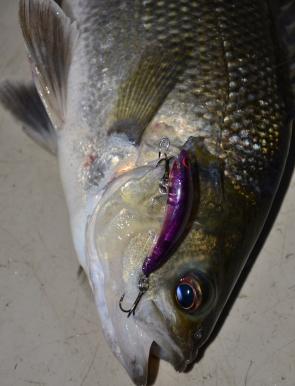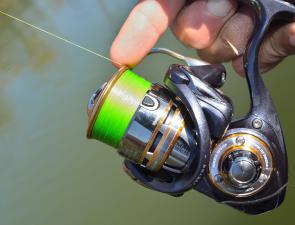Last issue I ran through some of my favourite bass surface lures so let’s now focus on how to make them.
As is often said, the best lure in the world may be useless unless it’s used appropriately. In simple terms, that means selecting a suitable lure for a given situation and then doing your best to encourage a fish to have a swipe at it.
Here I’ve listed what I consider the 10 most important points to consider when trying to pin a few bass on surface lures.
Without question, casting accuracy is vital when bass fishing, regardless of which lure you’ve tied on. If your accuracy is a bit off then you’ll end up with fewer fish and spend more time recovering lures from tree branches and the whole experience can start to become off-putting.
By far the best way to improve your casting skills is spend as much time fishing as possible; the more you cast, the better you’ll get. The next best thing is to practise in the backyard or a nearby park for an hour or two each week.
Whether you’re practising on the water or in the yard, the main thing to do is pick specific targets to aim for and keep your eye on the target as you cast.
Don’t worry if you’re a bit off the mark, just keep at it and keep looking at exactly where you want the lure to land. Make a few adjustments along the way and after a while you’ll get closer.
Once you’re consistently landing the lure where you want, try a different target, slightly further away. Keep changing the target distance and try casting with different lure weights.
Baitcaster or threadline? Use the reel that feels the most comfortable and is able to cast your chosen lure weights. Remember, too, that your index finger should be used on the lip of a threadline’s spool in exactly the same way as your thumb on a baitcaster spool.
If you don’t apply at least a little thumb pressure on a baitcaster the spool will overrun and the lure will miss its target. Feather the threadline spool with your finger to slow the line and stop the lure where you want it.
If you’re having trouble seeing the lure, it’s going to be harder to make accurate casts. Cricketers use a white ball at night because it’s easier to see. A dull green lure is harder to keep track of than a yellow lure when you’re casting towards bankside foliage.
Early in the morning I often start off with a brighter lure that enables me to make reasonably accurate casts in the low light. As it starts to get lighter I may swap to a darker lure, depending on how the fish are reacting to the lure I start with.
Towards the end of the day I may also swap back to a brighter lure if I’m having difficulties with casting accuracy. However, in most cases, you’ve tuned in and are reasonably accurate after an hour or two on the water and may still be able to make accurate casts with a black lure as light levels fade.
Bass also may start to venture farther out from their lairs towards nightfall, so casting accuracy may not be as vital.
Of course, it’s also beneficial to see your lure on the water and during the retrieve. That’s why a lot of poppers have a bright red or orange cupped face. A lot of lures are easy enough to keep track of when the sun is high in the sky or you can simply see or hear the commotion that some lures create during the retrieve.
If, however, you’re having problems seeing your surface lure, try marking the front of the lure with a splash of hi-viz paint – orange is good.
Sometimes it’s important to select a lure that closely resembles what the bass may be feeding on in the place you’re fishing. The term ‘matching the hatch’ comes from fly-fishing, where it can also be essential to match your fly to imitate insects that have hatched out and the trout are feeding on.
Some common types of food that bass at times focus in on include termites, cicadas, shrimp, prawns and herring. When these are on the menu and abundant, bass may become almost impossible to catch with lures that don’t look anything like the real thing.
So although it’s not always easy to match the hatch when targeting bass with surface lures, we can only try. If bass are feeding on herring then something like a Lucky Craft Sammy or OSP Bent Minnow in a fishy-looking colour may be the best choice.
If plenty of cicadas are around, try a Megabass Siglett, Tiemco Cicada or something similar. Thankfully though, bass are often more opportunistic and will have a swipe at anything that looks like it could be edible.
There are three main considerations when choosing the leader.
It needs to be strong and abrasion-resistant to withstand bass that try to bury you deep in thick weed or timber.
Secondly, it shouldn’t be too thick or heavy for the lure you’re casting, otherwise it may pull a small surface lure under or adversely affect its action.
Thirdly and this is probably the least important, if it’s too thick or visible it may put off bass and they won’t hit the lure. This is only likely if the water is super-clear and the bass are in a hesitant mood.
A 4kg or 5kg fluorocarbon leader is about right for most creek or river bass fishing when using average-sized lures and the bass aren’t monsters that can bust you up. If, however, you are fishing where big bass are more common then a 6kg or 7kg leader would be a better choice but this may start to affect the action of some smaller lures.
If you’re lucky enough to be casting in a waterway full of big, angry bass it’s essential to use 10kg or even 12kg.
I prefer a leader like Sunline FC Rock but if you prefer mono then it’s hard to go past tough stuff like Schneider, Maxima or Jinkai.
Remember that most lures perform better on a loop knot rather than a clinch knot. Simple surface poppers, Heddon Torpedos, Jitterbugs and Sigletts are a few of the exceptions that work perfectly well with a normal blood knot.
The sharper the hooks, the higher the chances of a successful hook-up. So before each outing, check the lures you intend using and replace suspect hooks.
Next time you buy a couple of lures, take note of their hook size and buy a pack of the same hooks. Vanfook, Owner, Gamakatsu and VMC are some good brands to consider.
Once you’ve cast out your lure, it’s time to think of it as a living creature that a bass is going to eat. Consider it as an insect, frog, lizard or fish on a leash!
Try to make it look as lifelike and realistic as possible by thoughtful rod work and mixing the retrieve speeds. Don’t rip it through the water unnaturally or flay it about noisily, you’ll only scare the fish.
Sure, there are times when bass won’t hesitate about hitting the lure on a straight, boring retrieve but in the long run you’ll do a lot better by making the lure dance around on the water as if it were really alive and in a panic because it knows it’s about to get eaten.
At the opposite end of the spectrum, just letting a lure sit motionless can be incredibly effective at times. In fact, a lot of insects that fall to the water do just that – nothing.
So if a more lively approach doesn’t seem to be working on the day, just cast and when the lure lands, don’t do a thing. If a bass has noticed it but is a bit reluctant to take a swipe, the longer the lure sits there the more likely the fish is to become so curious or even enraged and will eventually give in and hit the lure.
How long you leave a lure sit there depends on how much time you’ve got. A bass may still hit a lure that’s been sitting on the water for 10 minutes or more.
This is possibly the most important tip of the lot. Rather than spending time travelling from spot to spot, changing lures, having a chat or a bite to eat, just get that lure in the water so it’s got a chance of a bass finding it.
At all times when I’m fishing for bass or any other species, my highest priority is having a bait or lure in the water.
If it’s not in the water, there’s no chance at all of catching a fish. So just keep casting!
The more confident you are, the more likely you’ll do all of the above things, because you know that success is coming your way. An angler who doesn’t feel confident will probably spend more time changing lures, moving from spot to spot or just not casting enough.
While it’s easy to feel confident if you’re already getting stuck into a pile of good fish, it’s also easy to lose confidence when things aren’t going your way. The only way to regain that all-important confidence is to keep telling yourself that fish have to be there and you will find them and catch them.
As bad as things may seem, try to resist any feeling of defeat, remain happy and positive and keep at it.
Sometimes surface lures aren’t the best choice. Even if a surface lure is a very reputable model, the bass may simply not be interested in smacking something off the top at the time. So if you’re casting away and not doing any good, there’s a reasonable chance you’ll begin to lose that all-important confidence in the lure.
The reality is that bass won’t always hit surface lures, whether it’s an expensive Megabass or a cheapie bargain-bin job. So before blaming the lure, try something like a soft plastic, spinnerbait or diving hardbody. If it works you’ll get on the scoreboard.
Later in the day or some other time, try surface lures again and things may be different. Don’t just assume that if a surface lure is supposed to be really good that you’ll automatically catch bass with it.
Adopt an open-minded approach and you’ll end up catching bass on surface or down deeper. Stubbornly stick to surface lures and you’ll catch bass when they’re in the right mood but don’t complain if your results aren’t as good as you hoped.
Reads: 2156
Most of the time bass will have a go at just about anything but there are also times and places when they’ll focus in on a particular type of food item. When bass are like this it’s time to ‘match the hatch’ with whatever lure you’ve got in the box that i

It’s not too hard to head out and pin a few bass like this but to consistently do well on bass with surface lures, it pays to adhere to the main points outlined in this article.

It’s important to use an appropriate leader and attach the lure with a loop knot to get the best out of stickbait lures like this.

It’s certainly not going to be difficult keeping track of noisy lures like these fizzers, but some more subtle types aren’t so easy to see when light levels are low. Some anglers like do splash hi-visibility paint at the front of their lures.

Quite often bass will be tucked right in or under snags like this and won’t respond to a lure that lands too far out from the snag. It pays to work on your casting accuracy and get in there nice and close.

Even though the Aussie-made Viking Pop’n’Crank is quite an effective lure on a straight retrieve, it’s still a good idea to give it some extra life with rod movement and pauses along the way.

The index finger can be used on the lip of a threadline spool to help control accuracy, much like the thumb on a baitcaster spool. The more you practise casting, the better you’ll get, regardless of which type of reel you use.




